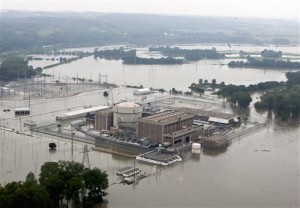Back in April, 2011, the Fort Calhoun nuclear power plant, on the banks of the Missouri River about 19 miles north of Omaha, was shut down for refueling. The timing was perfect because in June, 2011, the Missouri River flooded. As pictured above, the plant that had been on the shore of the river was suddenly in the middle of the river.
THE PLANT IS STILL SHUT-DOWN – 20 Months after the incident.
Erin Golden, of the Omaha World News, told me on Dec. 19, 2012,
The plant is expected to be $129 million over budget in 2012. The OPPD [Omaha Public Power District] has set a target for the First Quarter of 2013 to bring the plant back on line. And the people at OPPD are optimistic that they will get the plant back on-line. The NRC, however, is not optimistic.
Ms. Golden covered this in more detail in “20 months after shutdown, signs of change at Ft. Calhoun nuclear plant.”
The Fort Calhoun nuclear plant is now about 37 years old. Even if it was running, it would be nearing the end of its useful life. Fortunately, it’s a small plant, comprised of a single 480 MW reactor. While it would still cost OPPD $129 Million to maintain the plant in this “zombie” state where it is neither fully decommissioned nor generating power, the utility could, for between $1.2 and $1.8 billion, build 600 MW of nameplate capacity wind and solar. The extra 120 mw of nameplate capacity should enable the utility to meet peak demand. Neither wind nor solar power require fuel or waste management systems or extensive, expensive, redundant and failsafe safety systems. (My best estimate is $6 to $7 billion to replace the old 480 MW reactor with a new 480 MW reactor. This is about $1.5 to $2 billion to decommission the existing reactor and $5 to $5.5 to build a new one.)
I spoke with David Locbaum, at the Union of Concerned Scientists, about Fort Calhoun in June, 2011 (here), who said,
Most of the releases of radioactive material, generally tritium and tritiated water, occur when plants are online. Because the plant was offline, very little radioactive material has been released into the biosphere as a result of the flooding. While it is easy to filter heavy metals, it is very expensive to isolate tritiated water from water.
The damages due to the flooding are likely to be in the ballpark of $1,000,000 per day in lost revenue – $23 Million since June 6 – because the plant produces power worth about $1,000,000 per day. The buildings that have been damaged are collateral buildings, not the reactor itself. Those buildings would be less expensive to repair than the reactor.
In the summer of 2006, I also spoke with then-Senator Jon Corzine about nuclear power. He told me,
It costs about the same to maintain a nuclear plant that is not generating electricity as it does to run a nuclear plant that is generating electricity.
This explains Fort Calhoun’s $129 Million budget overrun: OPPD has to spend money on salaries, safety, power to keep the plant safely not-operating, however, it is also not selling any electricity.
–
I am interested in working on this shifting energy paradigm. I hold a Bachelor’s in Biology and an MBA in “Managing for Sustainability” from Marlboro College. I can be reached at ‘L Furman 97” @ G Mail . com and US 732 . 580 . 0024.
